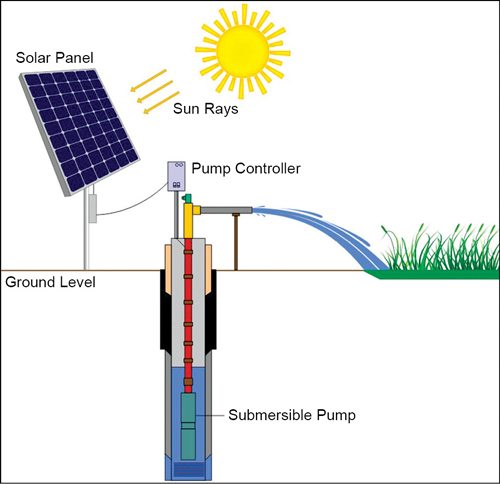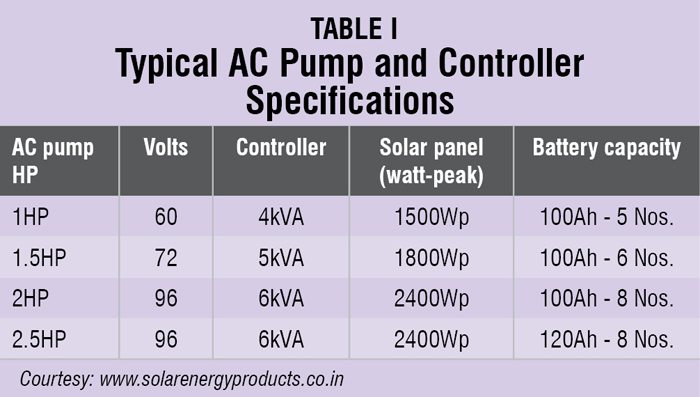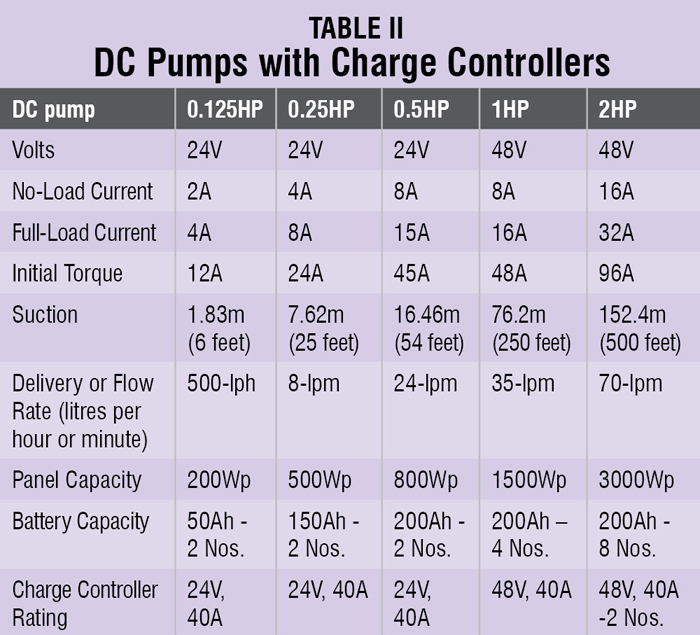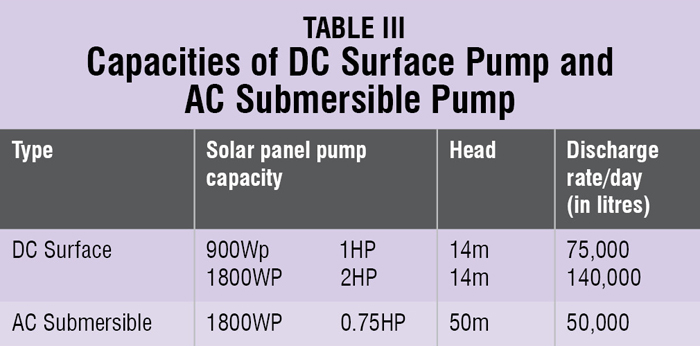This article describes the different components of solar Power irrigation systems, various specifications, different techniques used, the current scenario in India, the challenges faced by consumers, and the future scope of solar-powered irrigation systems.
Solar-powered water pumping systems can find application in town water supply, livestock watering, and irrigation. The solar-powered irrigation system is an application of a solar-powered water pumping system used in paddy fields, and gardens for watering plants, vegetables, etc. A typical example of a solar-powered irrigation system is shown in Fig. 1.

Advantages of Solar Power Irrigation System
1. It makes irrigation possible in remote areas
2. Is environment friendly
3. No grid connection is required
4. No electricity bills to be paid
5. No fuel is required
6. Is durable, requiring minimal maintenance
Solar Power Irrigation System – Types
- Surface Irrigation, in which water is moved across the surface of agricultural lands.
- Localized Irrigation, like spray or drip or trickle system where water is applied to each plant or adjacent to it.
- Sprinkler Irrigation, in which water is piped to one or more central locations within the field and distributed by overhead high-pressure sprinklers or guns.
Essential Components
The actual components and hardware requirements depend on the type of irrigation system, such as-
The major components of a typical solar-powered pumping system include a solar panel array that powers a bore-well pump or surface pump. The size of the complete system is dependent on the size of the pump, the amount of water required per day, and the power available from the solar panels.
The water is often pumped from a borewell or stream into a storage tank or directly into the field.
Solar Power Irrigation System has three main parts:
- Motor pump
- Pump controller
- Solar panel
Motor Pump
The pump has a motor running on electricity generated by the solar panel. Depending on the type of motor (AC or DC), the voltage of the solar pump motor can be AC or DC. DC motors are primarily used for small to medium applications, such as garden fountains, landscaping, drinking water for livestock, or small irrigation projects. Most DC pumps run at 24 volts rather than 12 volts.
However, smaller systems for 12 volts do exist for light-duty applications, while systems running on 48 volts also exist for heavier applications. The power of a motor is specified in either watts or horsepower (HP).
Pump Controller
There are two types of pump controllers: inverter and variable frequency drive (VFD). If an AC solar pump is used, an inverter becomes necessary to change the DC from the solar panels into AC. The supported power range of a typical inverter extends from 0.15kW to 55kW, with the higher power inverter being used for larger irrigation systems.
The solar panel and inverter must be sized accordingly to accommodate the inrush characteristic of an AC motor. Since the AC pump requires high power at the start, the inverter should be able to handle this extra start-up load. Sometimes a VFD controller is used to ensure that the pump motor gets proper voltage and current. Some typical specifications for various AC pumps and pump controllers are listed in Table I.

Many solar DC pumps require a special controller if they are to be powered directly by PV modules (without batteries). The controller or linear current booster (maximum power point tracker) enables the pump to start and run in low light conditions during a cloudy day, or early morning and evening. With a battery power source, the controller may not be required at all for a DC pump.
A special controller may also be employed for converting 12-volt battery power to a higher voltage to run the pump at top speed. The DC pumps are available from 12V to 48V with their initial torque varying from 12A to 96A. Typical specifications of various DC pumps and charge controllers available from a vendor are listed in Table II as an example.

Solar Panel
The pumps are fitted with motors that receive energy from solar PV arrays. The nominal power of a solar module is expressed in peak wattage (Wp). The wattage of solar panels depends on the requirement and the motors used. In India, solar PV arrays having a capacity in the range of 200W to 5kWp are recommended by the government.
Recommended: Solar Panel Specifications
Many vendors offer installation services at a cost. But if you are planning to install it yourself, you can refer to many live video clips available on the Internet.
You can check the Solar Panel Installation Guide.
Types of Motor Pumps
Solar pumps fall into two major categories, surface, and submersible, depending on their construction and applications.
Surface Pump
A surface pump is usually installed above the water level which requires a suction lift. It is used to get discharge from an open well, pond, or river where high flow and a small head (height to which the water needs to be lifted) are required. There are many different types of pumps available, and DC surface pumps with a total lift of up to 21m (70 feet) are easily available in India.
Submersible Pump
This pump is basically a hermetically sealed motor. The whole assembly of the submersible pump is submerged in the water to be pumped up. It is generally used for pumping water from small borewells and is designed to fit inside the drilled bore. The well may be anywhere from a few meters to 550 meters deep.
But the deeper the well, the more powerful and expensive would be the system. The 0.25HP to 3HP pumps are easily available in the market. DC submersible pumps with a total lift of up to 92m are quite common in India.
Submersible pumps have the ability to lift water to a greater height. So these pumps are also used for water transfer applications from a canal to storage tanks or from an underground storage tank to an overhead tank.
How to Select the Right Pump?
Before buying a pump you should know the depth at which water is available, the daily water requirement, and the type of irrigation system to be installed. You may also need to know the water flow rate and the total head of the pump. It would be best if you bought a pump having the best efficiency. The best combination of head and flow rate at the least energy consumption gives the best pump efficiency.
The performance graph of a 1.5HP motor pump available from a vendor is shown in Fig. 3 as an example. To interpret the graph and the table, let us say you have an input power of 400 watts from the PV array and want to lift the water to a height of 40 meters at a flow rate of 12 liters per minute. As per Fig. 3, you would need a 1.5HP pump-set with a pressure of 56.88psi or 392 kilopascals (392kPa).

The next step is to decide whether you should go for an AC pump or a DC pump. Though a DC pump can be run directly from a solar PV array, it has a minimal range as compared to an AC pump.
The DC pump costs more than the AC pump with the same category and the same head. But if a DC pump is available in your local market that meets your requirement, it can be worth buying.
“One should buy an AC submersible pump because the maintenance for a submersible is almost nil as compared to a DC pump,” says Hitesh Kapuriya, assistant manager, of JJ PV Solar Pvt Ltd.
Indian manufacturers of pump sets for various applications can be found at https://www.pumpsindia website. The type of motor pump, the wattage of the solar module, accessories, etc are some of the decisions you have to make.
So before buying the system, you should check the following:
- Solar water pump installation site. You should first check whether it will be installed near a pond, river, or somewhere else.
- Pump setting depth. The accessories required for underground installation would be different and add to the overall cost.
- Requirement of daily water. If you need more water per day, you need heavier and more powerful equipment.
- AC or DC pump. For an AC pump, you need a solar panel, pump controller (inverter), module mounting assembly, and accessories like cables, connectors, and pipe. For the DC pump, a pump controller would not be required in case of direct connection with the PV panel.
In addition, you may consider installing solar trackers and pump protection units. The complete system should be tested and certified by an authorized test center to get the best performance and water discharge norms as specified by the ministry.
Various capacities of DC surface and AC submersible pumps available from a vendor are listed in Table III, just for your information.

Current Scenario of Solar-powered Irrigation Systems in India
Nearly 60% of Indians work as farmers in the field of agriculture. But due to the non-availability of electricity in remote areas, irrigation becomes difficult even if the land is fertile as it depends majorly on rainfall only. Solar energy can save not only electricity but also save Indian farmers (during drought and scanty rainfall) who are otherwise prone to suicide.
Solar water pumping systems can make irrigation possible even in remote areas. The pumps are available for various types of irrigation, including paddy fields, horticulture farms, gardens, etc.
“The present scope of solar power irrigation systems in India is very good because there is support from nodal agencies in the states like Rajasthan, Bihar, etc. The Ministry of New and Renewable Energy, Government of India, gives 30 percent subsidy for a five horsepower solar water pump set,” says Hitesh.
Unfortunately, the “Average cost of the solar water pumping system is Rs 450,000. Government policy for subsidy is having restriction up to 5HP solar pump only,” adds Hitesh.
Besides the high cost of solar irrigation systems at present, another problem is the lack of awareness of the benefits among farmers and consumers.
Solar Power Irrigation System – Future Scope
With advancements in technology, the systems can be made more user-friendly. You can control the motor pump from a remote location using your mobile phone. You can get water level indication of the reservoir and overhead storage tank on your mobile phone. These technologies are already available in the market, though presently they are not so popular.
For further information on this subject, you may refer to the ‘Irrigation Automation Opportunities in Rural Areas’ article published in January 2012 issue. Also, you may refer to DIY articles on related topics, such as ‘Cellphone-Based Remote Controller for Water Pump’ published in January 2013, and ‘GSM-Based Borewell Water-Level Monitor’ published in May 2012 issues.
The author is a B.Tech (electronics & communication) from Punjab Technical University










I understand that In Off grid Solar powered AC pumping system consists of a battery bank & Solar charge controller, , apart from solar panels, Solar inverter & AC pump.
The charge controller charges battery from solar panels & Inverter converts DC from battery to AC to power the pump.
Is the above understanding correct??
correct, but batteries are not essential either without batteries, they works fine and efficiently. also, it does not required any maintains as such.
What should be the DOD of batteries used in Solar powered AC pumps for irrigation ?
I want solar pump of 7.5 hp
For my farm what will be the complit cost including installation
I want to install a sprinkler system at my boat dock area. I have access to the river water. My questions:
1–Can I use a a timer to set and water several stations?
2–Do I need a battery storage system?
3–Can I get an estimate on cost?
4–How difficult is it to install?